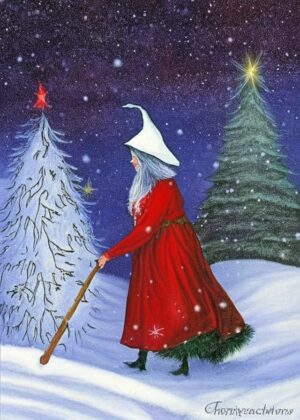Ever wondered about the famous Italian witches who’ve made history? Italy is packed with stories of magic and powerful witches. Known for Stregheria, witchcraft has been a huge presence in Italy, both positively and negatively. Witches in Italy are infamous, going back thousands of years.
Growing up, my Italian grandmother (from the South of Italy) used to tell me stories about the dangers of the Strega, or the Italian witch. Witchcraft has a huge presence in Italy, so there are many infamous Italian witches.
In this post, we’ll explore the most famous witches of Italy. Let’s dive in!
What is Italian Witchcraft?
Italian witchcraft, often referred to as “Stregheria,” is a rich and complex mash-up of beliefs and practices rooted in the ancient traditions of Italy. This form of witchcraft can be traced back to the pre-Christian era, when the Romans and Etruscans practiced rituals dedicated to various gods and goddesses, nature spirits, and ancestral spirits.
Over time, as Christianity began to spread across the Italian peninsula, these ancient pagan practices didn’t disappear; instead, they adapted and merged with the new religious context. This amalgamation led to a unique blend of Christian and pagan traditions, rituals, and folklore.
Throughout history, the strega (female witch) or stregone (male witch) played a crucial role in local communities. Often, they were the healers, seers, and wise folk that villagers would turn to for guidance, remedies, and blessings. Their practices would often include the use of herbs, divination, and invoking the aid of spirits or deities like Diana, Aradia, and others.
However, like in many parts of Europe, the witch hunts and trials of the Renaissance and Early Modern period also touched Italy. Many accused of practicing witchcraft faced persecution, further pushing Stregheria and its practitioners into the shadows.
What’s interesting is that while many Italian witches were healers, the Italians seem to be much more afraid of the strega in general than, say, Celtic tribes. Even today, the strega is considered the kiss of death.
With that being said, there are some pretty powerful Italian witches in history. Let’s dive in and learn more about these women.
Famous Italian Witches
Here are the top 8 most famous Italian witches in history you should know about.
8. Aradia di Toscano

When talking about witches in Italy, Aradia di Toscano often tops the list. A key figure in the world of witchcraft, many believe Aradia was the very first witch in Italy. As told in Charles Leland’s “Aradia, or the Gospel of the Witches” from 1899, Aradia was no ordinary person. She was said to be the daughter of Diana, the Moon and Witchcraft Goddess, and Lucifer, known as the Light-bringer. So, why was she here? Aradia had a special mission: to teach regular folks, especially those having a tough time, the ways of witchcraft. This was a way for them to stand up against the big bosses of the time.
Aradia, as portrayed in Charles Leland’s “Aradia, or the Gospel of the Witches,” wasn’t exactly depicted as a figure to be feared by the common people. Instead, she was presented as a savior or teacher to the oppressed peasants. She was sent to Earth to teach them the ways of witchcraft to empower them against their oppressors.
However, it’s conceivable that the ruling classes, clergy, and others in positions of power who became aware of her teachings might have feared her — or at least the empowerment and rebellion she represented. This is because Aradia’s message was about leveling the playing field, about giving the downtrodden the means to rise against their oppressors using witchcraft.
7. Tanaquilla

Going way back to the ancient days of Rome, Tanaquilla was a revered prophetess and the wife of the fifth King of Rome, Lucius Tarquinius Priscus. Her most notable act was foretelling her husband’s rise to the throne. Legend has it that while still living in their hometown of Tarquinii, Tanaquilla had a vision that they would become king and queen of Rome. Her predictions didn’t stop there. She also foresaw the end of his reign, advising him to prepare for a sudden and tragic end.
Tanaquilla’s wisdom wasn’t just limited to prophecies. She played a crucial role in the political landscape of Rome during her time. After her husband’s assassination, she managed to maintain stability in the kingdom by masterfully managing the transition of power to her son-in-law. With her foresight and diplomatic skill, Tanaquilla solidified her place as one of the most impactful witches in ancient Italian history.
6. Befana

A beloved figure in Italian folklore, Befana is often termed as the ‘Christmas Witch’. Although she’s not a deity or saint in the conventional sense, her origins have pagan undertones. Befana is an old woman who, on the eve of the Epiphany, flies on her broomstick to deliver gifts to children throughout Italy, much like Santa Claus in other cultures.
While her origins are murky, some stories link Befana to the Roman goddess Strenia, who gifted branches of evergreen trees at the start of the year as a symbol of enduring life and fortune. Befana’s association with the magical act of flying, her giving nature, and her connection to ancient Roman traditions make her an enchanting figure in Italy’s magical history.
5. Benedetta Carlini

In the 17th century, Italy was a hotbed of religious fervor and mysticism. One notable figure from this period is Benedetta Carlini, a Catholic nun who lived in Tuscany. She began having mystical visions at a young age, which led many to believe she had a divine connection. However, as she rose to power within her convent, her claims became more sensational. She professed to have regular conversations with angels and even claimed to be the bride of Christ.
As time went on, the church became suspicious of Benedetta’s claims. They conducted an investigation, during which they concluded that her visions were not divine but rather the work of the devil. The church’s verdict was that she was a false mystic, and she was confined to her cell for the remaining 35 years of her life. Despite her tragic end, Benedetta Carlini’s story highlights the tension between religious institutions and individual spiritual experiences, making her a noteworthy figure in the history of Italian witchcraft
4. Cagliostro’s Wife, Lorenza Feliciani

While Count Alessandro di Cagliostro often steals the limelight when discussing 18th-century occult figures in Italy, his wife, Lorenza Feliciani, deserves recognition in her own right. Often known as Serafina, she was deeply involved in her husband’s esoteric activities, including the rites and practices of Egyptian Freemasonry, which the Count had developed.
Serafina was not only a close confidante but also an active participant in many of the Count’s mystical ceremonies. While she faced her fair share of trials, including imprisonment due to her involvement in the infamous “Affair of the Diamond Necklace,” her spirit remained undeterred. She stands as a symbol of resilience, with stories hinting at her capabilities in divination and alchemy, making her a significant figure in the annals of Italian witchcraft.
3. Sabina Magliocco
Fast-forwarding to more contemporary times, Sabina Magliocco, while an anthropologist by profession, has contributed immensely to the understanding of modern Italian witchcraft, folklore, and paganism. Born in Italy and raised in the United States, Magliocco’s works, like “Witching Culture: Folklore and Neo-paganism in America,” shed light on the modern practices and revivals of ancient traditions.
While not a witch in the historical sense, Sabina’s role in documenting and analyzing the traditions of Italian witchcraft cannot be overstated. Through her scholarly pursuits, she has provided a bridge between the ancient and the contemporary, ensuring that the stories, rituals, and practices of Italy’s magical heritage continue to be known and understood in today’s world.
2. Girolamo Segato
Living in the early 19th century, this Italian anatomist and traveler was known for his peculiar method of petrifying human bodies. His techniques, which remain a mystery to this day, allowed him to preserve human tissues in ways that resembled marble statues.
His most famous work was his own body. After falling terminally ill, he reportedly applied his technique to himself, turning his remains into a morbid masterpiece. The lines between science and magic blur with figures like Segato, reminding us that sometimes, the most bewitching tales come not from spells but from the unknown realms of human capability.
1. Janara or Janas
From the region of Sardinia come the tales of Janara or Janas, which are enchanting nocturnal witches. These witches were believed to be skilled in spinning, weaving, and had the power to heal. They would sometimes leave behind small woven items as signs of their visit. Sardinian lore is filled with stories of these women, who were thought to reside in rock-cut tombs or sacred wells. They bridged the worlds of the living and the dead and were considered guardians of ancestral wisdom and arcane arts.
Diving into the world of witches in Italy is like opening a book full of cool stories. From the old tales to the famous Italian witches everyone talks about, there’s a lot to discover. These famous Italian witches have left a mark, and their stories are a big part of what makes Italy so special in the magic world. When we think of these witches in Italy, we see a mix of the old and the new, and it’s awesome to see how their tales continue to inspire many today.


